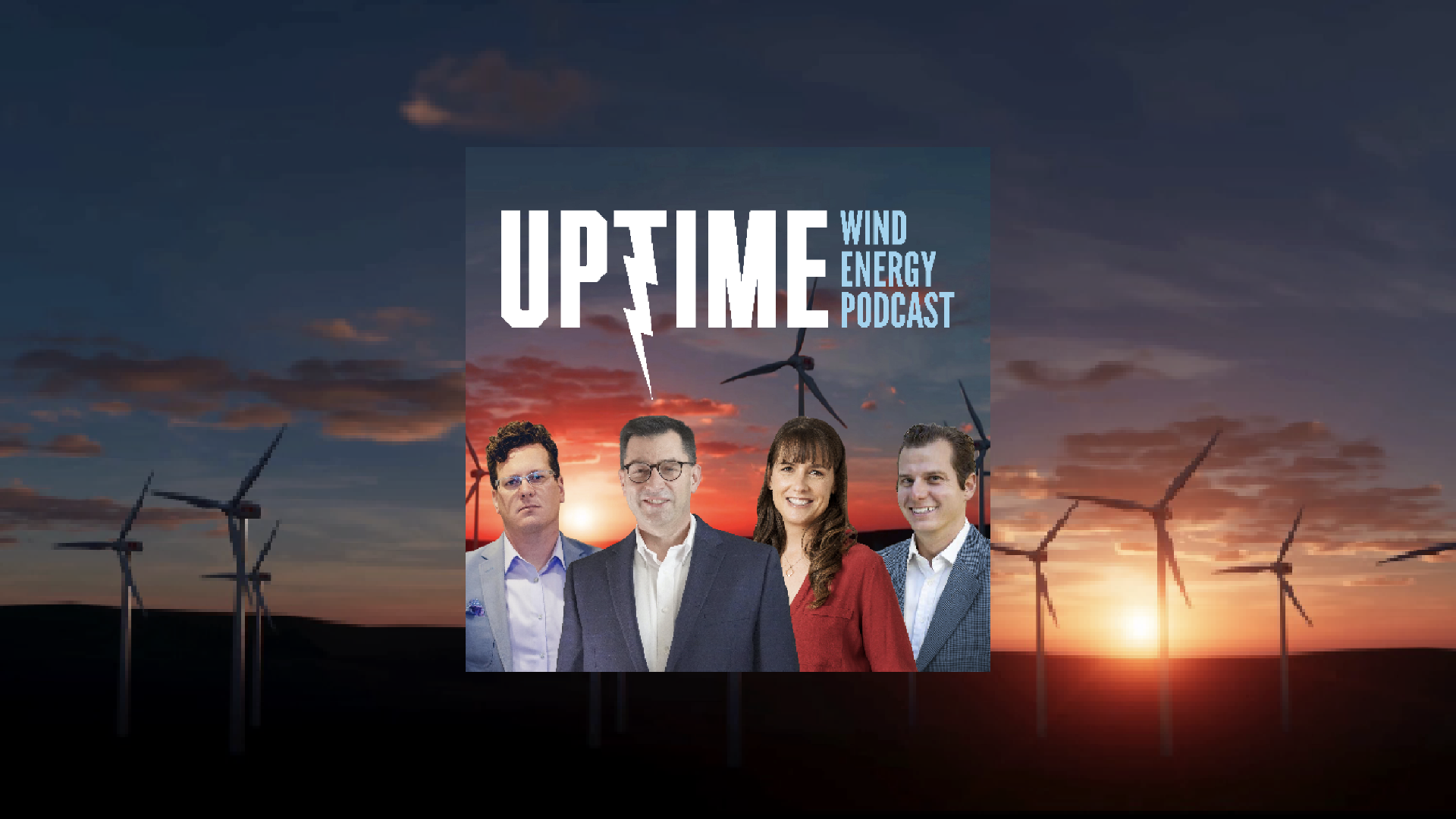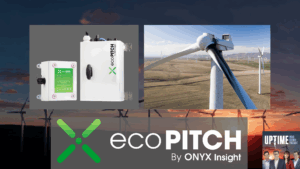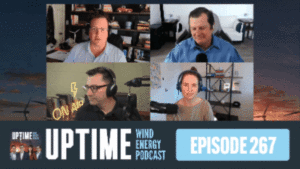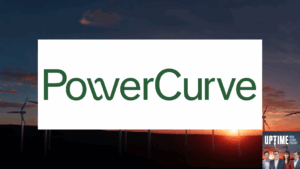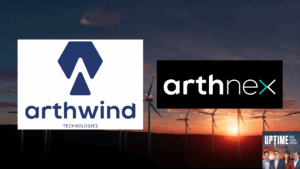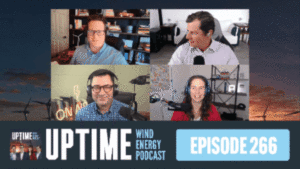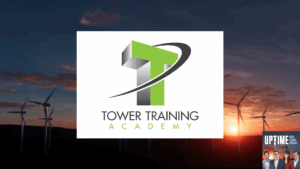Podcast: Play in new window | Download
GE Vernova is suing SKF USA for $386 million over failing bearings, and American Electric Power (AEP) is suing GE Vernova for wind turbine failures. WUPROHYD is looking to combine wave, solar, and wind power generation into a single floating structure, potentially revolutionizing offshore renewable energy production. BP’s CEO is moving company focus away from renewables. DOF Group acquires Maersk Supply Service for $1.11 billion in a cash and stock deal. Jupiter Bach is facing challenges due to EU sanctions on Chinese fiberglass. Nordex plans to restart production at its facility in Iowa. Bureau of Ocean Energy Management (BOEM) has issued key approvals for two major offshore wind projects: Atlantic Shores South and New England Wind.
Sign up now for Uptime Tech News, our weekly email update on all things wind technology. This episode is sponsored by Weather Guard Lightning Tech. Learn more about Weather Guard’s StrikeTape Wind Turbine LPS retrofit. Follow the show on Facebook, YouTube, Twitter, Linkedin and visit Weather Guard on the web. And subscribe to Rosemary Barnes’ YouTube channel here. Have a question we can answer on the show? Email us!
Pardalote Consulting – https://www.pardaloteconsulting.com
Weather Guard Lightning Tech – www.weatherguardwind.com
Intelstor – https://www.intelstor.com
Allen Hall: Welcome to the Uptime Wind Energy Podcast. I’m your host, Allen Hall, and I’ll be bringing you this week’s top stories in the wind energy sector. BP is making significant changes to its strategy under new CEO Murray Auchincloss. The oil giant has implemented a company wide hiring freeze and paused new offshore wind projects.
This marks a stark departure from the previous leadership’s focus on rapidly transitioning to renewable energy. Auchincloss is redirecting the company’s focus back to oil and gas investments, particularly in the Gulf of Mexico and U. S. shale basins. Dozens of employees previously working on new renewable opportunities have been reassigned to existing projects, and the company is also expected to make job cuts in its renewable sector, though specific numbers haven’t been announced.
These changes come as BP faces investor discontent over its energy transition strategy, And underperforming shares. The company is now aiming to balance its decarbonization goals with the current high demand for oil and gas. Industry analysts see this as a significant shift in BP’s approach to the energy transition, potentially setting a new trend in the oil and gas sector.
Moving on to global shipping news, Norwegian supply shipping company, Dof Group, has agreed to acquire Maersk Supply Service for about 1. 1 billion. Dof will pay 577 million in cash and issue new shares worth 1. 1 billion. Merrick Supply Service Holding set to own 25 percent of Doff’s shares after the transaction.
The combined company will operate under Doff’s name and remain listed on the Oslo Stock Exchange. The deal is expected to close in the fourth quarter of this year. DOP plans to finance the acquisition through a 500 million dollar debt facility and up to 125 million dollars in equity. In related news, a new company called Maersk Offshore Wind has been launched to accelerate offshore wind deployment.
The company will provide installation services. Using a new wind installation vessel concept, which is estimated to reduce installation time of offshore wind turbines by about 30 percent compared to conventional methods. This efficiency is expected to lower overall installation costs for developers.
The first vessel is scheduled for delivery in 2025. Maersk Offshore Wind, a spinoff of Maersk Supply Service, is owned by AP Moller Holding and will be headquartered in Denmark. The company aims to support the growing offshore wind market, particularly in Europe and the U. S., where ambitious targets for install capacity have been set for 2030 and 2050.
European wind industry supplier Jupiter Bach is facing challenges due to EU sanctions on Chinese fiberglass. The company’s CEO warns that high tariffs on raw materials But low tariffs on finished products are incentivizing production in China over Europe. JupiterBot is recommending that the EU require locally produced content in the wind industry to maintain European production capabilities and knowledge base.
In U. S. manufacturing news, Nordex Group has announced plans to restart production at its facility in West Branch, Iowa. The company will manufacture nacelles for its current N163 turbine model and a new product designed specifically for the U. S. market. Production is scheduled to begin in the first half of 2025 with an annual capacity expected to exceed 2.
5 gigawatts. This move is part of NORDEX’s growth strategy in North America and aims to meet domestic content requirements while creating new jobs in the U. S. Lastly, the Bureau of Ocean Energy Management has issued key approvals for two major offshore wind projects, Atlantic Shore South, which will generate up to 2.
8 gigawatts for New Jersey, Received a record of decision. New England wind is set to generate up to 2. 6 gigawatts for Massachusetts. Got approval for its construction and operations plan. These approvals mark significant progress in the U. S. offshore wind industry, with BOEM having now approved nine projects tolling more than 13 gigawatts of offshore wind energy in the development pipeline.
That’s this week’s top news stories. Now let’s welcome our co host, CEO and founder of InterStor, Phil Totaro, and the Chief Commercial Officer of WeatherGuard, Joel Saxo.
In some recent legal developments affecting the wind energy sector in the United States There are two significant lawsuits involving GE Vernovo. And the first one is with SKF bearing manufacturer for about 380 million. And then the second one is with AEP suing GE Vernovo over wind turbine failures, primarily focused on SKF bearings.
So this is a big deal. Where, wherever this, these lawsuits go, whether they settle or not, which they probably will there is a significant bearing issue out in service on a bunch of GE turbines. And I would assume this probably exists on other turbines, but maybe just not as well noticed. But it has to do with the coating on the bearings, Joel, there’s a diamond light coating, a very hard coating that’s applied to some of these bearings.
that from what I’m hearing from the field starts to flake off and then gets stuck into the lubrication system and then gets all caught up in the bearing. It is a huge problem. And I know when we traveled through Texas and Oklahoma operators brought this up to us.
Joel Saxum: Yeah, for sure. Imagine going to your car and opening up the oil reservoir and just pouring some metal chunks in there and then expecting your motor to last.
That’s just not how it works. So when this coating flakes off, it gets ground up a little bit smaller than the flakes, but not much because the coating is super, super hard. So it just creates. Basically debris within the lubrication system. So where they’re supposed to be. Solid bearing material, solid ball bearings or rollers rolling against a, or a guide you now and with grease in there, of course, you now have impregnated in all of that grease, all kinds of little particles that are chewing up your bearings.
We heard to the point where the bearing races got chewed through by this basically mixture of this coating and the grease so much that the roller bearings were falling out of the actual bearing race. And that, That’s extreme.
Allen Hall: And Phil, this has implications on a grander scale about service agreements, right?
That I think AEP is using GE. I think it’s maybe under warranty still, but there are also a lot of operators that are, have service agreements with GE. It puts a lot of pressure on GE Vernova at a time that they don’t really need it. And it opens a door, I think, to a lot of ISPs offering services that maybe GE doesn’t want to do anymore.
Does that make sense?
Philip Totaro: The reason why this is a big deal now is that A, it was leaked out. It’s not, it’s public information, but it’s not something that people would have necessarily known about had it not been for somebody tracking and finding the complaint that got filed in the state of New York where there’s also, an ongoing legal battle between GE and a bearing supplier SKF on, some of those main bearing issues that you mentioned, including the diamond light coating.
But AEP’s complaint against GE, they actually identified pitch bearing outer raceway issues gearbox torque pin migration they also identified cracks in TPI made blades Let’s see, blade edgewise vibration issues on TPI made blades, LM blade root delamination issues. There was also a blade liberation event that they specifically identified.
This has impacted three of AEP’s biggest project sites, which use GE 2. 0 I want to say 2. 5 116s and 2. 0. 8 1 27. And this is more than a gigawatt worth of capacity installed between these three project sites. The traverse Maverick and Sundance projects in Oklahoma. So these turbines are, probably not unique in the issues being experienced.
Although again, a lot of this does come back down to how are they being operated? What’s the turbulence intensity at the site, et cetera, et cetera. And that’s been GE’s kind of position is, an owner operator brings up these kind of maintenance issues and these breach of contract issues on.
The faults, failures, and the general state of operation and the availability of the plant. GE’s kind of, it feels according to AEP and the complaint that they filed, it feels like GE’s slow rolling them on a response. They’re basically saying, oh, we need time to investigate what’s really going on, and do all this root cause analysis, et cetera, et cetera.
And AEP’s hey, we’ve been telling you almost since day one that there’s been some issues. And you guys haven’t been fully addressing it.
Allen Hall: Joel, doesn’t this bring up a number of different operators and their affiliated OEMs? I can think of one in particular that’s having a similar issue, not with bearings but with some blade issues.
That seems to be pretty widespread, but in these cases where it is a difficult engineering problem to solve, and we’re pushing the boundaries very rapidly on what can be manufactured and what can be produced these kind of events, Joel, seem like they’re inevitable at some level, right? That you push a diamond like coating hard enough, eventually it’ll fail.
If you push a blade hard enough in particular aspects that eventually it’ll crack. We just don’t have enough history on some of these turbines to show a 20 year lifespan isn’t that part of the point, is that we’ve just designed ourselves into a corner, taking away some of the safety margins and those sort of things, just trying to lean them down to be more cost efficient.
Isn’t this the likely outcome?
Joel Saxum: It is. And the trouble here is that, okay, say take that same platform Phil was just talking about. The one about the AEP GE SKF lawsuits. That 2. 3 to 2. 8, so we call them the GE 2X machines, right? The 116, 127 meter rotors. There’s something like 9, 000 and change in those installed just in the U S.
So what happens with these people, whether this is a GE problem or you’re talking about other issues in the marketplace, Festus, Siemens, Kamesa, whoever it is they all have this. Some kind of serial defect type thing going on at some level. There’s, you can find a mistake like that in almost every manufacturer’s product line.
They don’t have the horsepower to go and fix these things, right? If GE all of a sudden goes, there’s this lawsuit goes through, everybody hops on board right behind AEP. And this thing turns into 10 operators suing GE and trying to get some kind of recourse from it. There’s not enough money, time or people right now in the wind industry to go and fix all these problems.
You’re not there. You’re not going to go and replace 9, 000 main bearings. Sorry. Like we don’t, there’s not enough cranes. There’s not enough people. There’s not enough money to go do that right now. So engineering, these opportunities. So this is the follow, but like getting back to your question, Allen We’ve, in my opinion, now I’m not a engineer in a factory building wind turbine parts.
I’m not Rosemary, right? I’ve never done that. But yeah, we’ve pushed ourselves so hard in this arms race to get the biggest, baddest, best turbines out there that we’ve cut safety margins down and changed things so fast and didn’t possibly, this bearing thing is a hard thing to test. To be honest with you, because they not, it’s not like it’s a high speed rotating piece of equipment where you can, figure some meantime before failure out by just cranking the thing up.
This is a slow rolling, doesn’t really move a whole lot kind of piece of equipment much like a pitch bearing is the kind of the same thing. They’re hard to test.
Allen Hall: If there’s going to be this defect problem, let’s go, let’s call it a defect just to simplify the situation. So say there’s some sort of defect.
In the bearings, GE still may not know what’s causing them. I agree with Joel here. They probably did a ton of testing on these bearings and have service experience with the coating. I think it wouldn’t fail. These wind turbines are getting, becoming more complex, right? As they have reduced safety factors, they’re getting modes of loads that are slightly different.
That’s why they have this blade cracking issue. Probably also, is it just The combination of all these variables that’s adding up, that something is happening to the bearings, and subsequently. Is there a fix that doesn’t involve replacing all the bearings? Do we know that yet?
Philip Totaro: This is more of a, if we’re gonna call it a serial defect issue, again, this is what’s in the AEP, legal complaint against GE they’re calling it a serial defect issue.
That’s a, first of all, a different scenario, but it’s not as much necessarily related to operation. This is, what we sometimes refer to, and slightly unfortunate phrase here, but infant mortality rate of components in the industry. So there’s that kind of a a scenario that has to be dealt with.
And those components just need to be swapped out. But if they’re seeing an actual operational related failure within, these projects were, installed in 2021 and operational in 2022, they shouldn’t be seeing where related faults and failures that fast, unless there was a manufacturing defect.
Allen Hall: But I think the other factor, which is unknown from the bearing manufacturer’s standpoint. Is things like generator currents and currents flowing around the nacelle up there that. You as a bearing manufacturer have no control over either, right? And I think that’s actually comes up in one of the complaints is talking about current flow in the nacelle running through the bearings.
Philip Totaro: We need more data sharing in the industry. Because that is the only thing that is going to solve this problem. Show us your data. Get that stuff out there so people can start looking at it. It doesn’t mean that it’s going to drive up your insurance premiums. There are ways we can shield that information from people that you don’t want to share it with.
But start putting mechanisms in place where people that are having similar problems, other owner operators that have similar problems to you, are able to take a look at the data you’ve got, what problems you’re having, start a conversation, and share information, and that is going to reduce these faults and failures.
Allen Hall: I do think that the operators, especially large operators like AEP, Participate in ESIG and a number of other types of operator conferences where they do discuss these things. I think the missing link right now is who at an operator’s site has someone super knowledgeable about the coding that is applied to a GE bearing.
I don’t know who that would be. I haven’t run across that person. I’d say they don’t exist, but it doesn’t seem like someone you necessarily carry on your staff. And that’s a problem, right? I think it’s also a limited number of people with the knowledge to go investigate it and to come up with some conclusions.
I know there’s, GE’s full of smart people, right? I’m sure they have applied smart people to a difficult problem. But from my read of the situation, it doesn’t look like they have identified a one possible cause. This seems like there’s three, four, five of them right now.
Philip Totaro: That’s correct. And to their point, they do need to do a full RCA and all this stuff.
Whether or not they are culpable under the contract for having allowed some of these potential serial defects into, because what, here’s what happens when GE signs a supply contract with SKF, or Timken, or anybody. They have certain guarantees provided by that subcomponent manufacturer. But at the end of the day, in the turbine supply contract to, in this case it was Invenergy that built these sites, and then sold them to AEP, there’s like a line drawn in the sand that says GE is liable here.
And that if there’s an issue with the performance of the bearing, even though it’s technically, GE has to go work it out with the bearing supplier, GE’s the one that’s contractually liable to the owner operator.
Joel Saxum: A trade off there. Phil, you say share the data. Allen, you say, yes, great, but there’s not always an expert.
Why not get the, do the share of the data, but get the subject matter experts involved? So where does this go?
Allen Hall: What’s the likely outcome of all this? Between AEP, GE, and SKF.
Joel Saxum: Phil’s right. I think Phil said, I think you said earlier Phil it won’t go to trial. They’ll settle. There’ll be some money changed hands.
And then GE will do a little bit of horse trading with AEP.
Philip Totaro: You’re right, Joel. This isn’t the first time that an OEM’s been sued for issues or had issues with an owner operator. But it, the fact that this has been, Made so public, it’s triggering a lot of conversations now amongst ISPs independent service providers, and owner operators.
And, OEMs to say, look, if we’re not getting what we need from you, we’re going to cancel your, full wrap service contract. And we’re going to go to this independent service provider, or we’re going to start domesticating that knowledge and capability in house. To repair our own stuff.
Joel Saxum: Let’s do some simple math here. Let’s just, this is just for interest sake. Okay, so let’s take Traverse. And we say there’s 356 turbines on that farm. And we’re gonna say half of them have an issue. 178 turbines have an issue. So say we gotta replace the main bearings on 178 turbines. That is, you have a crane on site.
Basically, it probably takes a, you can hook the thing in a morning, get it down to the ground. How long do you think it takes to swap that bearing out? Say it’s two days. So you’re looking at 300, we’re going right back up, 356 working days. Okay, we’re not working on Sundays, so we’re gonna take that out of there.
You’re looking at 60 weeks of working time with one crane, and that’s without encountering any weather, which you’re going to have. If you had one crane, it would take you probably two years To do those of it nonstop and a crane is sometimes depending on what the crane is, those things are 20, 30, 000 a day.
Philip Totaro: Well, which by the way is what makes was it Treehouse that just invested in Liftworks? That’s what makes that investment so important, I think, at this point.
Allen Hall: From a GE looking forward perspective and a little bit looking back, I think. Is this something that they knew was in the background for the last year or so, and this explains why they’ve made some of the decisions they made to essentially reduce staff, cut down on the number of models, probably focus on what they have, and less on development, obviously they said they were doing that.
Does this problem, and maybe just because of how maybe widespread it is, force that kind of action upon G. E. even though they weren’t really talking about it, they had to have known in the background this was going on.
Philip Totaro: Oh yeah, they would have had to have known that this was gonna be coming. Again, considering how we operate projects in the U.
S. now, this isn’t just this PTC farming that I keep talking about, that’s not new. This has been going on since we started doing the repowering, the PTC driven repowerings, in 2017. We’re getting experienced enough.
Allen Hall: Where’s the certification body in all this?
Philip Totaro: Counting their money.
Allen Hall: Did anybody mention that? Who’s,
Joel Saxum: who is going after the type certification body? Contractually, they’ve got something that, that makes them non liable, I almost guarantee that.
Allen Hall: Sure, right? And the airplane world is very similar. An airplane crashes, the FAA comes back and looks at it, and says everything was within process, the standard process, everything, all the boxes were checked properly.
Things just broke. Okay. We’ll go back and future airplanes won’t have that problem. Here, the certification body, which is a private organization is putting their stamp of approval on these turbines. And then two years in they’re having massive Serial defect issues, something’s wrong, right? Cause GE is going to point to the certification body.
AEP probably is also, right? I got the certificate. It says everything’s cool. And SKF as a bearing manufacturer says, I passed the CERT test, the type certification test for this application. Everybody’s just gonna be pointing at one another, right? And when it gets into court, somebody’s gonna say that.
They’re gonna ask what was the consequences of having a certification if we’re just ignoring it. When things get tough. How do they step out of this? I don’t know. But it does seem like that is part of the missing link. As wind energy professionals, staying informed is crucial, and let’s face it, difficult.
That’s why the Uptime Podcast recommends PES Wind magazine. PES Wind offers a diverse range of in depth articles and expert insights that dive into the most pressing issues facing our energy future. Whether you’re an industry veteran or new to wind, PES Wind has the high quality content you need. Don’t miss out.
Visit PES wind.com today. So in this issue of PES Wind Magazine, a good article, and we don’t talk about this a lot, but I’m interested in Wave Energy and you don’t see a lot of deep articles about how to use wave energy. I know there’s some really good designs that have been out there. Putting them in the field and getting something tested.
That’s a different story. And I think there’s been a lot of worry about wave energy, how durable it’s going to be and those kinds of things. But as we move offshore, particularly for floating wind, I think wave energy is a possibility, and I think there’s some unique opportunities at the moment to do something.
And there’s a Polish design firm called WuProHyde, W P R O H Y D. that is working on innovative wave turbine technology to take power out of the ocean waves. And they’re, what they’re. Describing in the magazine is a three part system, an energy island, so to speak of wind, floating wind with solar on these platforms and on the top of the platform is solar, on the bottom of the platform is a wave energy system such that they can maximize the output of these Energy islands.
And if they give some numbers here, but basically what they’re saying is somewhere between 21 and 34 megawatts could be generated by the system in the North Sea per module. That’s a lot. That’s a lot of power generation without a lot of more complexity. Obviously there’s some here you’re building this little platform for these solar panels and wave generators to sit in, it looks fairly straightforward.
And my question to everybody here is, why haven’t we seen more combos of solar, wind, and gas? Wave, wind, wave solar being thought of or trialed right now.
Joel Saxum: So last year, Allen, exactly what this article is about. I sat in a panel at OTC, the offshore technology conference, mainly focused on oil and gas, but they had some renewable energy technologies in, which was great.
But one of the panelists actually the lead was talking about designs for this exact same thing, like we hate. We’re gonna, if you have offshore floating wind or offshore fixed bottom wind, you already have the infrastructure in place, the cables are ran the expert, like everything’s there. Why not add more generation to it?
The other side of that, too, is if you put in the wave generators for power. Now you’re creating power at night. During the day, during different weather patterns, all kinds of different stuff, right? So you’re optimizing the time, the, the uptime of that generating asset. So it just makes sense.
And all of us have been to the beach, all of us have been to the ocean. Like the waves are always rolling, even when there’s a light breeze, there’s always waves moving. This, and there’s actually quite a couple, there’s a couple of other concepts out there that are taking advantage of tidal.
Currents, because again, like that’s something you could set your clock by when title currents move so that resource is always going to be there. So I think that this is something that should be explored a little bit more. The tough thing I think that you’re going to hear from people in the industry is the operations and maintenance on it.
That’s something we’ve got to make sure that we can sort out.
Philip Totaro: That is part of it. The other reason why, going back to Allen’s original question, why we don’t see more of these being commercially deployed is the insurance companies are, unfortunately, as they tend to be, pretty risk averse, particularly when you start combining these different power generation systems on a single platform.
And the fact that, one thing happens, it takes down, three power generation sources now, instead of them being three independent ones. You’re also talking about more electrical infrastructure out there in the water. Bigger substations, bigger converters, etc. So there’s kind of trade offs, both commercially and technologically, to that.
The other thing is that the wave energy converters haven’t been as reliable or efficient. When you can go out and get 50, 60, whatever percent capacity factor from an offshore wind farm, with particularly low turbulence intensity, these wave energy converters are maybe doing 8 to 10 percent conversion efficiency.
It hasn’t been the best performing technology, but it’s early, and there’s obviously some economies of scale that can happen. I don’t, however, ever see the wave Energy technology being deployed as a commercial power generation source by its own. I do the concept of combining it with different power generation technologies to do what Joel was just describing and take advantage of, continuous power generation, regardless of, whether or other operational circumstance.
So that seems like a reasonable thing to be able to do.
Allen Hall: So if you haven’t, Okay. Received your copy of PES Wind, the latest issue. You can download it at peswind.com. A lot of great articles in this issue a lot to catch up on. So check it out at peswind.com.
Joel Saxum: This week’s Wind Farm of the Week is the Richland Wind Farm is in Iowa, owned by Aligned Energy, so SAT county, Iowa, and it’s started, it’s, producing of energy in September of 2020. There, the wind farm has 53 GE 2. 5 megawatt machines with 127 meter rotors for a 131 megawatts total hub height as about 295 feet on these things. So they’re pretty high. They were designed for a medium wind with a design speed of 17 miles per hour. So this wind farm was part of a line energies strategy of putting over 1.
8 billion into wind energy back in the, this was in the 2020. So the last one, this was the last wind farm of a larger plan to add five new wind farms to Iowa, which they did right before COVID. So some interesting things about this wind farm. I found a little bit of information online October and November, and then jumping to March and April are the, actually the best producing months year by year for the Richland wind farm.
And by that, that’s when they make the most amount of power. So the most recent data shows that about a little over 560 gigawatt hours of annual generation came from the Richland wind farm in the last 12 months. And that is good to be number 40 out of 123 wind power plants in Iowa. And I bet you didn’t know there was 123 wind farms in Iowa. So number 40 out of 123 in Iowa and 335 out of 1, 329 in the United States nationwide and that’s for wind power plants. The interesting one, you expand that to all the power plants in the country and if you rank the Richland Wind Farm by how much power it produced in the last 12 months, it ranks number 1, 239 out of 11, 249 total power plants.
So Richland Wind Farm in Iowa? You are our windfarm of the week.
Allen Hall: That’s going to do it for this week’s Uptime Wind Energy podcast. Thanks for listening. Please give us a 5 star rating on your podcast platform and subscribe in the show notes below to Uptime Tech News, our weekly newsletter. And check out Rosemary’s YouTube channel, Engineering with Rosie, and we’ll see you here next week on the Uptime Wind Energy podcast.



